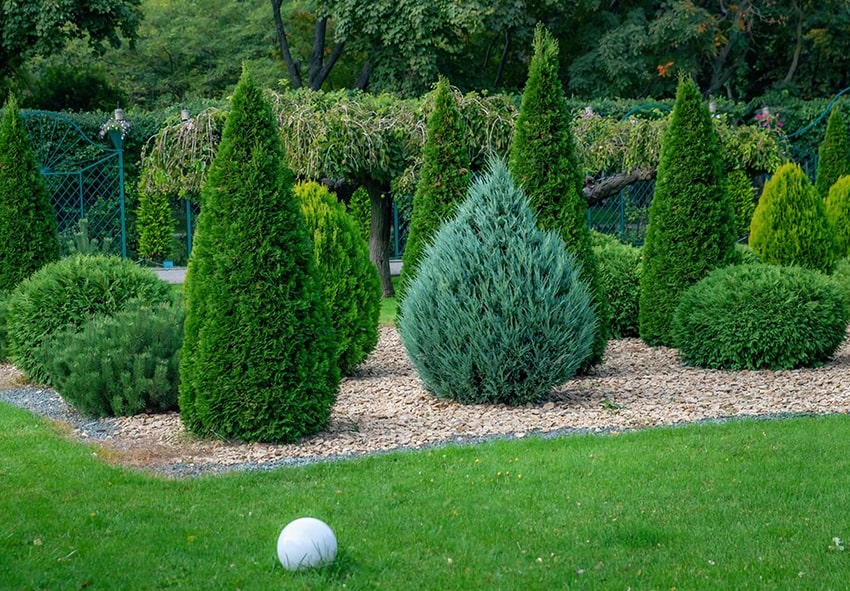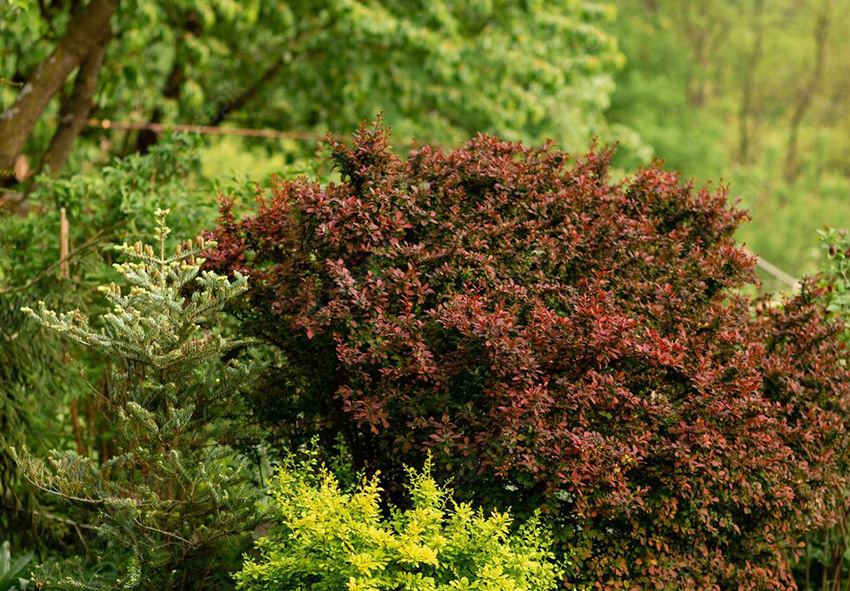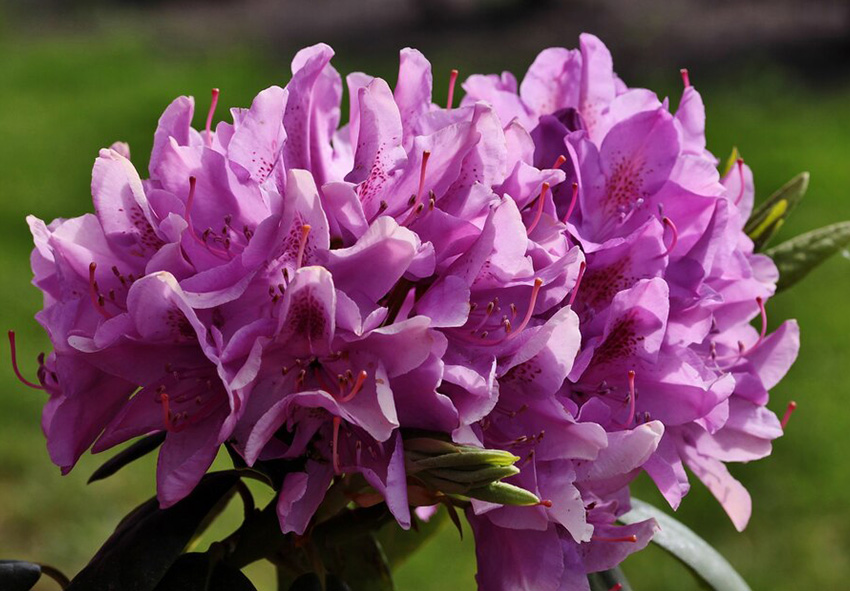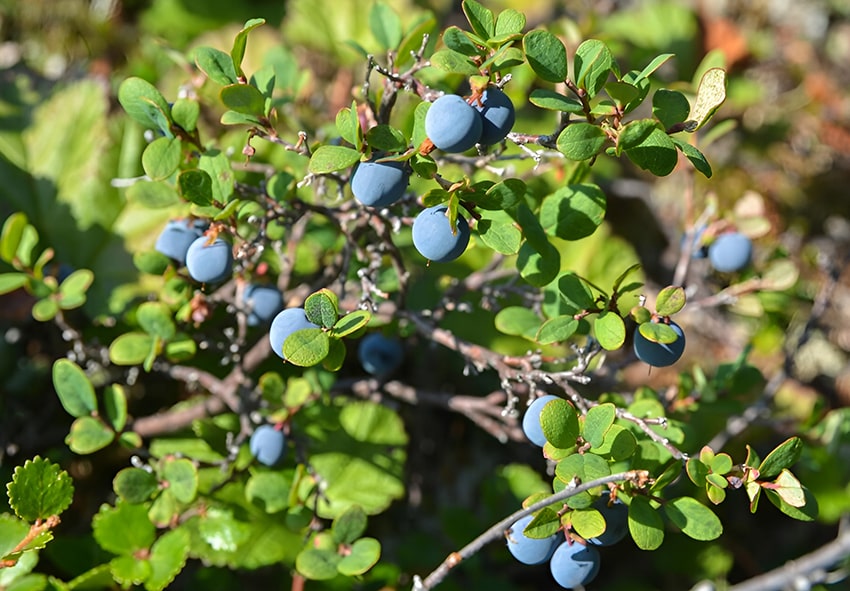Explore Different Types of Shrubs and Bushes for Your Garden
Shrubs and bushes are versatile plants that can enhance the beauty and functionality of your garden. They can provide color, fragrance, privacy, wildlife habitat, and more. But with so many types of shrubs and bushes to choose from, how do you decide which ones are right for your landscaping needs?
Evergreen shrubs
Evergreen bushes are a necessary part of every expertly planned landscape. Evergreen shrubs keep their foliage all year round in contrast to deciduous shrubs, which lose their leaves at specific times of the year. Because of this quality, they are a great option for giving a landscape structure and interest all year round.
The adaptability of evergreen shrubs is one of their most important advantages. Since they are available in a variety of sizes, forms, and textures, they can be used in almost any type of garden, from formal to naturalistic. They can also be used for a number of different things, like accent planting, hedging, or screening.
Evergreen plants require little upkeep and are extremely simple to maintain. They don’t require much trimming, and the leaf acts as a natural mulch to keep the soil moist and control weed growth. They can thrive in a variety of soil types and have high drought tolerance.
Deciduous shrubs

Any well-designed landscape must have deciduous shrubs. They enhance the attractiveness and usefulness of any outdoor space with their adaptability and attractive design.
The ability of deciduous shrubs to adapt to a variety of environmental situations is one of its main advantages. They are robust and can survive in a range of soil conditions, solar exposure levels, and climatic conditions. Because of their versatility, they are a preferred option for landscaping projects because they may be utilized to design lovely garden beds, hedges, or borders.
The seasonal appeal of deciduous shrubs is another benefit. They produce stunning flowers in the spring that enliven the garden with color and texture. Their thick foliage offers shade and cover during the heat. Their autumn leaves change into an array of beautiful colors before falling, resulting in a breathtaking autumnal spectacle. Additionally, in the winter, their bare limbs cut a chic figure against the snow.
Flowering shrubs
Any landscape would benefit from adding flowering shrubs, which come in a variety of hues, forms, and sizes. They not only produce lovely blossoms, but their foliage, bark, and general form also provide year-round interest.
The adaptability of blooming shrubs is one of their main benefits. They can be utilized in many different ways, such as to line a walkway, create an eye-catching focal point, or fill up empty spots. They are a fantastic option for any gardener because they can be utilized in a variety of garden styles, from formal to naturalistic.
The low care needs of flowering bushes are another advantage. Once they are established, many shrubs are disease- and drought-resistant and require minimal maintenance from the gardener. They may also be pruned to preserve their size and shape, making it simple to include them into any garden design.
Fruit-bearing shrubs
Fruit-bearing shrubs are a necessary part of any farm or home garden since they offer a wide range of advantages that cannot be obtained from other kinds of plants. These bushes not only produce scrumptious and healthy fruits, but they also have a number of other benefits like enhancing soil quality, bringing in beneficial species, and enhancing the aesthetic appeal of the surrounding area.
The abundance of fresh, nutritious fruit that fruit-bearing bushes produce is one of their main advantages. Fruit-bearing shrubs are perennials that produce fruit year after year, making them a cost-efficient and sustainable option for any gardener as opposed to annual plants that need to be replanted every year. There are innumerable species of fruit-bearing shrubs to pick from, each with its own distinctive flavor and nutrient profile, whether you’re seeking for sweet berries, tart cherries, or luscious peaches.
Fruit-bearing shrubs provide a variety of additional advantages to the environment and the gardener in addition to their tasty fruit. In order to enhance soil quality and lessen erosion, these shrubs are frequently employed in agroforestry systems, where they are interplanted with other crops. Additionally, they draw beneficial wildlife, like birds and pollinators, which can boost yields and produce a more biodiverse ecosystem.
Finally, fruit-bearing plants are simply stunning to behold, bringing texture and visual appeal to any garden or landscape. From the delicate blooms of a blueberry bush in the spring to the vibrant colors of autumn leaves on a cherry tree, these shrubs offer a year-round display of natural beauty that can be enjoyed by anyone.
Dwarf shrubs

Any garden or landscape would benefit greatly from the inclusion of dwarf shrubs. These small plants are well-liked by homeowners, gardeners, and landscape designers due to their variety of advantages.
Dwarf shrubs are first and foremost very adaptable. It is simple to discover a selection of them that will exactly fit in any garden or landscape because they come in such a broad variety of forms, sizes, and colors. There is a dwarf shrub that will suit your needs, whether you’re searching for a colorful accent plant or a low-maintenance ground cover.
The simplicity of maintenance is another advantage of miniature plants. Dwarf shrubs require little pruning and upkeep in contrast to larger bushes, which can be time-consuming and challenging to maintain.
Dwarf shrubs have numerous uses and are simple to maintain, but they also have aesthetic advantages. They are a great option for tiny gardens or confined places because to their compact stature, and any landscape will benefit from their colorful foliage and blossoms, which provide texture and visual interest.
Tall shrubs
Tall shrubs are a crucial component in many landscape designs because they give outdoor areas height, structure, and solitude. As woody perennials with several stems, these plants fit that description.
The adaptability of tall bushes is one of their most important benefits. They are a great option for homeowners wishing to create a more private outdoor living space because they can be utilized to build privacy screens, windbreaks, and natural fences. Tall plants can also effectively block noise, lowering noise pollution and fostering a calm environment.
Additionally, there are many different kinds of tall shrubs that each have their own special traits, such as the texture, color, and timing of their blooms. This enables homeowners to choose plants that are appropriate for their unique landscaping requirements, from flowering species that bring seasonal interest to evergreens that offer structure and privacy year-round.
Tall bushes serve a variety of functional purposes in addition to being aesthetically pleasing. They can be utilized to frame flowerbeds or develop a landscape’s focal point. Additionally, they give vertical appeal to landscape designs, giving them depth and dimension.
Hedge shrubs
Hedge shrubs are an essential component of any well-designed garden or landscape. These versatile plants serve as natural boundaries, privacy screens, and decorative accents, adding both aesthetic and functional value to outdoor spaces.
One of the main advantages of hedge shrubs is their ability to create natural barriers, providing both privacy and security to homeowners. With their dense foliage and branching structure, hedge shrubs can effectively block out unwanted views and noise from neighboring properties.
Hedge shrubs are available in a wide variety of species, each with its unique characteristics and growth habits. From the classic boxwood to the colorful and fragrant lilac, there is a hedge shrub suitable for any garden style and climate. Additionally, many hedge shrubs are low-maintenance and can thrive in a range of soil types and light conditions, making them an ideal choice for busy homeowners and novice gardeners.
Topiary shrubs
In order to build sophisticated and stylish gardens, topiary shrubs are a necessity. These expertly sculpted plants may lend a touch of elegance and beauty to any outdoor area. They are a monument to the trade of shape and sculpting.
Topiary shrubs have aesthetic appeal in addition to their usefulness in defining spaces and establishing borders. These plants can be molded into many different shapes, such as spirals, cones, and spheres, to fit any garden design or individual preference.
Topiary shrubs also require little pruning and upkeep, making them comparatively low-maintenance plants. They are a durable and aesthetically beautiful addition to your garden and can live for many years with proper maintenance.
Adding Color to Your Garden: A Guide to Shrub Foliage Colors

Selecting shrubs with varied-colored leaves is one of the simplest ways to add color to your garden. The color of the foliage can range from variegated to green to yellow to red to purple to blue. The season or the quality of the light can also affect the color of the foliage.
Use green foliage as a neutral base for your garden. Green is the most common foliage color and it creates a sense of harmony and balance in your garden. Green foliage can also highlight other colors or textures in your garden. Yellow is a cheerful and warm color that can brighten up shady areas or contrast with dark colors. Yellow foliage can also create a sense of movement or energy in your garden. Use red foliage as a dramatic focal point for your garden. Red is a bold and fiery color that can draw attention or create excitement in your garden. Red foliage can also add warmth or depth to your garden. Purple is a cool and elegant color that can complement or contrast with other colors in your garden. Purple foliage can also create a sense of mystery or sophistication in your garden. Use blue foliage as a soothing element for your garden. Blue is a calm and serene color that can create a sense of relaxation or tranquility in your garden. Blue foliage can also add texture or interest to your garden.
Understanding Shrub Shapes and Forms for a Stunning Garden Design
Shrubs can have a variety of shapes and forms that affect their appearance and function in your garden. By choosing shrubs with different shapes and forms, you can create visual interest, contrast, harmony, and balance in your garden design. Here are some of the common shrub shapes and forms and how to use them in your garden:
- Arching: These are shrubs that have graceful, curved branches that arch over the ground. They add softness, movement, and elegance to your garden. They can be used as specimens, accents, or ground covers. Some examples of arching shrubs are forsythia, weigela, and spirea.
- Irregular: These are shrubs that have an unpredictable or asymmetrical shape. They add character, drama, and uniqueness to your garden. They can be used as focal points, specimens, or accents. Some examples of irregular shrubs are smoke bush, witch hazel, and Harry Lauder’s walking stick.
- Cascading: These are shrubs that have drooping or trailing branches that cascade over walls, rocks, or containers. They add texture, depth, and charm to your garden. They can be used as edging, ground covers, or spillers. Some examples of cascading shrubs are creeping juniper, cotoneaster, and blue rug juniper.
- Upright: These are shrubs that have vertical or columnar branches that grow straight up. They add height, structure, and formality to your garden. They can be used as hedges, screens, or backgrounds. Some examples of upright shrubs are arborvitae, holly, and privet.
- Spiky: These are shrubs that have sharp or pointed leaves or stems that create a spiky effect. They add interest, contrast, and excitement to your garden. They can be used as specimens, accents, or edging. Some examples of spiky shrubs are barberry, yucca, and sea holly.
- Rounded: These are shrubs that have a spherical or globular shape. They add fullness, balance, and neatness to your garden. They can be used as foundation plantings, borders, or mass plantings. Some examples of rounded shrubs are boxwood, hydrangea, and dwarf lilac.
- Mounding: These are shrubs that have a low-growing or spreading shape that forms a mound on the ground. They add softness, coverage, and color to your garden. They can be used as ground covers, edging, or rock garden plants. Some examples of mounding shrubs are lavender, heather, and potentilla.
- Vase-shaped: These are shrubs that have a narrow base and a wide top that resembles a vase or an inverted cone. They add elegance, openness, and grace to your garden. They can be used as specimens, accents, or underplantings. Some examples of vase-shaped shrubs are forsythia (again), lilac (again), and weigela (again).
Drought-Tolerant Shrubs: Low-Maintenance Options for Your Garden
If you live in an area with low rainfall or water restrictions , you may want to consider drought-tolerant shrubs for your garden. These are shrubs that can survive with little or no supplemental watering once established . They also tend to be low-maintenance , requiring less pruning , fertilizing , and pest control than other shrubs .
Russian sage is a perennial herb that grows like a woody shrub . It has silvery-green foliage and spikes of lavender-blue flowers that bloom from summer to fall . It attracts bees , butterflies , and hummingbirds to your garden . It grows best in full sun and well-drained soil. It can reach up to 4 feet tall and wide .
Rosemary is another perennial herb that grows like a woody shrub . It has aromatic , needle-like leaves and clusters of blue , purple , pink , or white flowers that bloom from winter to spring . It can be used for culinary , medicinal , or ornamental purposes . It grows best in full sun and well-drained soil . It can reach up to 6 feet tall and wide .
Butterfly bush is a deciduous shrub that produces fragrant , cone-shaped flowers in various colors from summer to fall . It attracts butterflies , hummingbirds , and other birds and insects. It grows best in full sun and well-drained soil. It can reach up to 10 feet tall and wide.
Benefits of Using Native Shrubs in Your Garden Design
Native shrubs are those that are naturally found in your region, without any human intervention. They have evolved to adapt to the local climate, soil, and wildlife conditions, making them more resilient and sustainable than exotic or introduced shrubs.
Native shrubs provide food, shelter, and habitat for a variety of native wildlife, such as birds, butterflies, bees, and other beneficial insects. They also help maintain the balance of the ecosystem by preventing the spread of invasive species that can harm native plants and animals. Native shrubs are well adapted to the rainfall patterns and drought cycles of your region, meaning they require less watering than non-native shrubs. They also help reduce runoff and erosion by stabilizing the soil and filtering pollutants.
Native shrubs are easier to maintain than non-native shrubs, as they are more resistant to pests, diseases, and environmental stresses. They also require less fertilizers, pesticides, and pruning than non-native shrubs, saving you time and money. Native shrubs offer a variety of colors, textures, shapes, and forms that can create a stunning garden design. They also reflect the natural beauty and character of your region, giving your garden a sense of place and identity.
Attracting Wildlife to Your Garden: Shrubs That Can Help

You should pick bushes that offer food, shelter, and nesting sites for wildlife if you want to build a garden that attracts birds, butterflies, bees, and other helpful critters. The following shrubs are some of the most effective for luring wildlife to your garden:
- Blueberry: This deciduous shrub yields wonderful blue fruits that are suitable for consumption by both people and animals. Additionally, it has red or yellow foliage in the fall that gives your garden color. It also has white or pink flowers in the spring that draw pollinators. It thrives in acidic soil, full sun, or light shade. It has a maximum height and width of six feet.
- Serviceberry: This deciduous shrub or small tree has purple-red berries in the summer that draw birds and other animals, as well as white blooms in the spring that draw pollinators. In the fall, it also has yellow-orange foliage that gives your garden color. It thrives in moist soil with full sun or light shade. It has a maximum height and width of 25 feet.
- Spicebush: This deciduous shrub bears early-spring yellow flowers that entice pollinators, particularly bees. In the autumn, it produces crimson berries that draw animals and birds, particularly thrushes. Additionally, it has golden leaves in the fall, which gives your garden color. It thrives in moist soil and light shade. It has a maximum height and width of 15 feet.
- Holly: An evergreen shrub with white spring flowers that draw pollinators and cone-shaped fruits that come in green, blue, or purple hues. It thrives on soil with good drainage and full light. Depending on the kind, it can grow to a maximum height and width of 25 feet.
- Winterberry: Winterberry shrubs are known for their vibrant red berries, which persist on the plant well into winter. They are an excellent source of food for birds during the cold months.
- Sumac: Sumac shrubs produce clusters of small red berries that many birds enjoy. They also have attractive foliage that turns bright red in the fall.
These are just a few of the many shrub varieties you might grow in your garden to enhance its beauty, intrigue, and advantages. You can pick a shrub that matches your preferences and requirements, whether you want one with flowers, fruits, or foliage. Shrubs require little upkeep and are simple to grow. They can persist for many years. Try a few of these shrubs in your garden to experience their allure and usefulness.
Popular and Versatile Shrub Choices for Your Garden
Here are some popular and versatile shrubs that you can consider for your garden:
- Buttonbush: This native shrub produces round clusters of small, fragrant flowers in the summer, which are followed by small, nut-like fruits that are a favorite of many birds.
- Azalea: Azalea bushes are known for their showy flowers in a range of colors, from pink to purple to white. They prefer acidic soil and partial shade.
- Rhododendron: Rhododendrons are similar to azaleas, but they have larger, more leathery leaves and showy flowers. They also prefer acidic soil and partial shade.
- Lilac: Lilac bushes are known for their fragrant flowers, which are typically shades of purple, pink, or white. They prefer full sun and well-drained soil.
- Forsythia: Forsythia bushes are known for their bright yellow flowers, which appear in early spring before the leaves emerge. They prefer full sun and well-drained soil.
- Hydrangea: Hydrangeas are known for their large, showy flowers in shades of blue, pink, white, and purple. They prefer partial shade and moist, well-drained soil.
- Boxwood: Boxwood shrubs are popular for their evergreen foliage, which can be shaped into hedges or topiaries. They prefer well-drained soil and partial shade.
- Spiraea: Spiraea bushes produce clusters of small, delicate flowers in shades of pink or white. They prefer full sun and well-drained soil.
- Juniper: Juniper shrubs are known for their needle-like foliage and blue or gray berries. They prefer full sun and well-drained soil.
Frequently Asked Questions (FAQs) about Trees and Shrubs
1. How do I select the right trees and shrubs for my landscape?
Choosing the right trees and shrubs for your landscape involves several key considerations. First, assess your climate zone and soil type to determine what plants will thrive in your area. Next, think about your specific landscaping goals, whether it’s for shade, privacy, or aesthetic appeal. Consider the mature size of the plants and their growth rate to ensure they fit your space in the long term. Additionally, take into account maintenance requirements and any local regulations or restrictions on certain species.
2. Can I order Holland trees and shrubs from your online store?
At our online store, we offer a wide range of trees and shrubs. You can conveniently browse our selection, compare products, and place orders online. We strive to provide quality plants to help you create your dream outdoor space.
3. How can I ensure the Dutch trees and shrubs I choose are low-maintenance?
To select low-maintenance trees and shrubs, consider native species that are adapted to your local environment, as they often require less care. Choose plants that are disease-resistant and have minimal pruning needs. Additionally, opt for drought-tolerant varieties if you live in an area with water restrictions. Properly matching the plant’s natural requirements to your landscape conditions is key to reducing maintenance efforts.
4. What are some trees and shrubs that attract wildlife to my garden?
To attract wildlife, choose trees and shrubs that provide food, shelter, and nesting sites. Native species like oaks, birches, and dogwoods are often excellent choices. Consider flowering shrubs like butterfly bushes or elderberries to attract pollinators. Research which birds and insects are native to your area and select plants that cater to their needs.
5. How can I create a visually appealing mix of trees and shrubs in my landscape?
To create an aesthetically pleasing landscape, focus on diversity in terms of size, shape, color, and texture. Mix flowering shrubs with evergreens for year-round interest and consider layering plants with different heights to create depth. Pay attention to the seasonal changes in foliage and blossoms to ensure your landscape looks attractive throughout the year. Consulting with a professional landscaper or using design software can also help you plan a visually stunning combination of trees and shrubs for your garden.
Published: 04.05.2023
